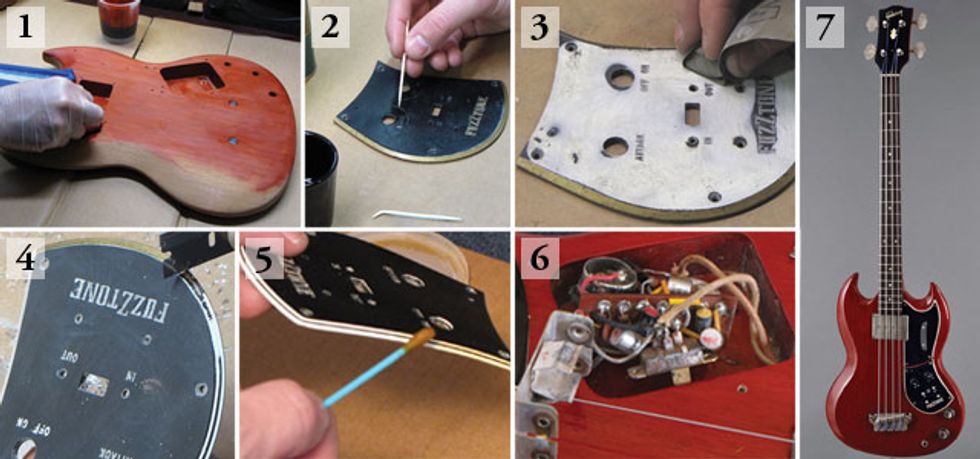1. Applying the premixed cherry-red grain filler. 2. Scraping out unwanted paint from the engraved
letters with Formby’s and a wooden toothpick. 3. Using up to 1000-grit paper to sand away layers of
non-original paint before buffing. 4. Using a razor blade to detail the sides of the plastic control plate.
5. Aging the white laminates by applying a water/acetone/stain mix with a Q-tip. 6. The fuzztone
controls and circuit board. 7. Our fully restored and totally cool Gibson EB-OF fuzztone bass.
Gibson manufactured the short-scale EB-OF bass from 1962 until 1965. The “F” stands for “fuzztone”—Gibson’s onboard circuit that produces pretty cool fuzz-like distortion. Clearly, not every bass player would want or use such a feature, but in the early ’60s, those eager to stretch out and test their musical boundaries would have found it appealing.
Gibson made the EB-OF with a doublecutaway slab mahogany body with rounded horns and a transparent cherry-red finish. Its one-piece set mahogany neck had peghead wings and a mother-of-pearl crown peghead inlay, and the 30.5"-scale rosewood fretboard sported 20 frets and dot inlays. Other features included a rosewood finger rest, a nickel-plated stud bridge/tailpiece, and a single humbucker with adjustable pole pieces and standard volume and tone controls. The fuzz circuit came with an in/ out switch and on/off and attack knobs.
When an EB-OF arrived at my shop for restoration, I realized I had a lot of work ahead of me. The original cherry finish had been brutally removed and needed to be restored. Major headstock and neck-joint breaks required repair and strengthening. Over the years, layers of different colored non-original finish had built up on the plastic pickguard and control plate. The humbucker pickup gave me a strong 26.3 Ω reading, but I saw that the potentiometers and fuzztone circuit board needed to be cleaned, and some solder points would require touching up.
I repaired the headstock and neck-joint cracks using industrial epoxy and highpressure clamps. I prepared the wood for its new finish by first sanding it with up to 280-grit paper, and then cleaning the body and neck with acetone to remove all the unwanted impurities that had impregnated the pores over the years.
Back in the day, Gibson used burlap material for applying the red-stained grain filler. It made for a messy job, as the burlap fibers would drift throughout the room and contaminate everything, so Gibson eventually discontinued this technique. I wanted to reproduce the look of the original early-’60s cherry finish, yet without all the mess.
I started with clear, waterbase ColorTone grain filler and mixed in some concentrated ColorTone #5038 cherry-red liquid stain. (I acquired all my finishing supplies from stewmac.com.) I tested the stain on a sample piece of mahogany until I got that old-school, deep-into-thegrain cherry look. I know there has been controversy within the repair community about using waterbase grain filler, but when I thinned it with the cherry-red liquid stain, it went on like butter.
Using a lint-free cloth, I applied the now-stained grain filler to the wood. The cloth worked well for burnishing in the grain filler, and best of all there were no fibers floating around in the air. After the grain filler was properly dry, I applied multiple coats of clear nitrocellulose followed by one coat of vintage tint.
To get the paint out of each engraved letter on the control plate, I used Formby’s Conditioning Furniture Refinisher. This product easily dissolves lacquer without aggressively stripping it away, a process that would damage the plastic material. I used wood toothpicks to scrape out the unwanted paint from the letters. A razor blade worked well to scrape off the non-original layers of gold, black, and white finish from the sides of the control plate.
Next, I sanded the plastic up to 1000 grit and then buffed it. I aged the bright white laminate sides of the plastic control plate using a water/acetone/stain mix applied with Q-tips. The water dilutes the acetone, which helps to gently burn the vintage-like stain into the plastic. Reminder: Always use appropriate ventilation when working with toxic chemicals like acetone.
This bass would have left the factory with a string cover, but in this case there wasn’t one. Typically string and bridge covers are the first items to get removed by owners, later to be lost forever.
After all the hardware and electronics were installed, I strung up the bass with a set of short-scale flatwound bass strings— just as Gibson would have done in 1963. What a cool bass!
 John Brown is the
inventor of the Fretted/Less
bass. He owns and operates
Brown’s Guitar Factory,
a guitar manufacturing,
repair, and restoration facility
staffed by a team of talented
luthiers. His guitar-tool and accessory designs
are used by builders all over the world. Visit
brownsguitarfactory.com or email John at
info@brownsguitarfactory.com.
John Brown is the
inventor of the Fretted/Less
bass. He owns and operates
Brown’s Guitar Factory,
a guitar manufacturing,
repair, and restoration facility
staffed by a team of talented
luthiers. His guitar-tool and accessory designs
are used by builders all over the world. Visit
brownsguitarfactory.com or email John at
info@brownsguitarfactory.com.






![Rig Rundown: AFI [2025]](https://www.premierguitar.com/media-library/youtube.jpg?id=62064741&width=1245&height=700&quality=70&coordinates=0%2C0%2C0%2C0)












 Shop Scott's Rig
Shop Scott's Rig

![Rig Rundown: Russian Circles’ Mike Sullivan [2025]](https://www.premierguitar.com/media-library/youtube.jpg?id=62303631&width=1245&height=700&quality=70&coordinates=0%2C0%2C0%2C0)













































